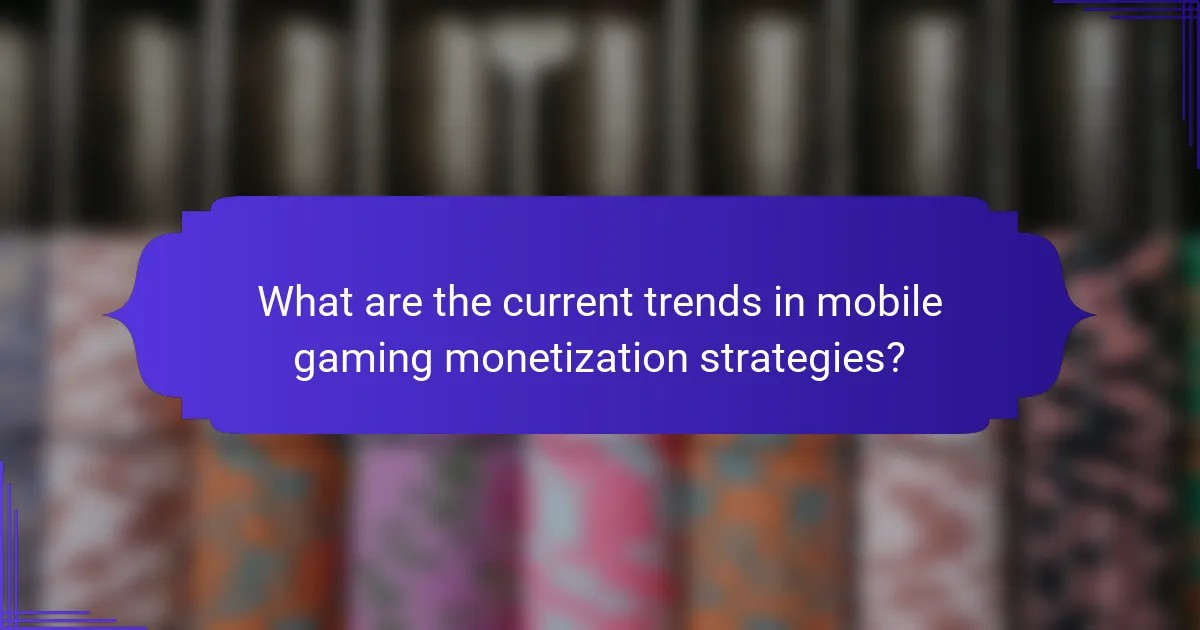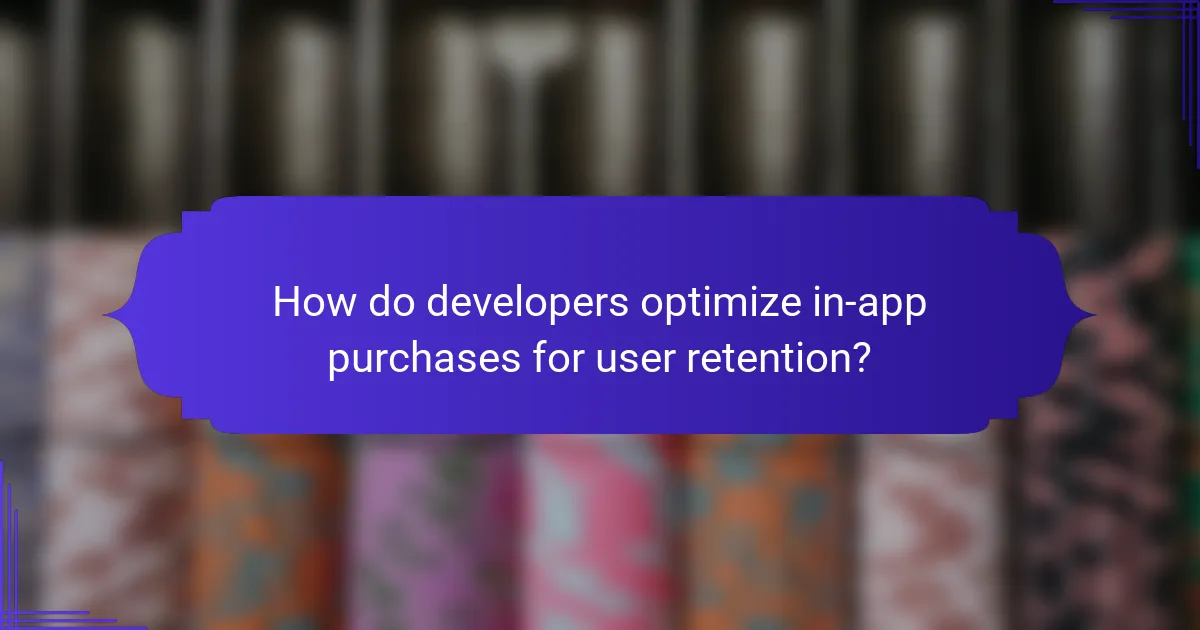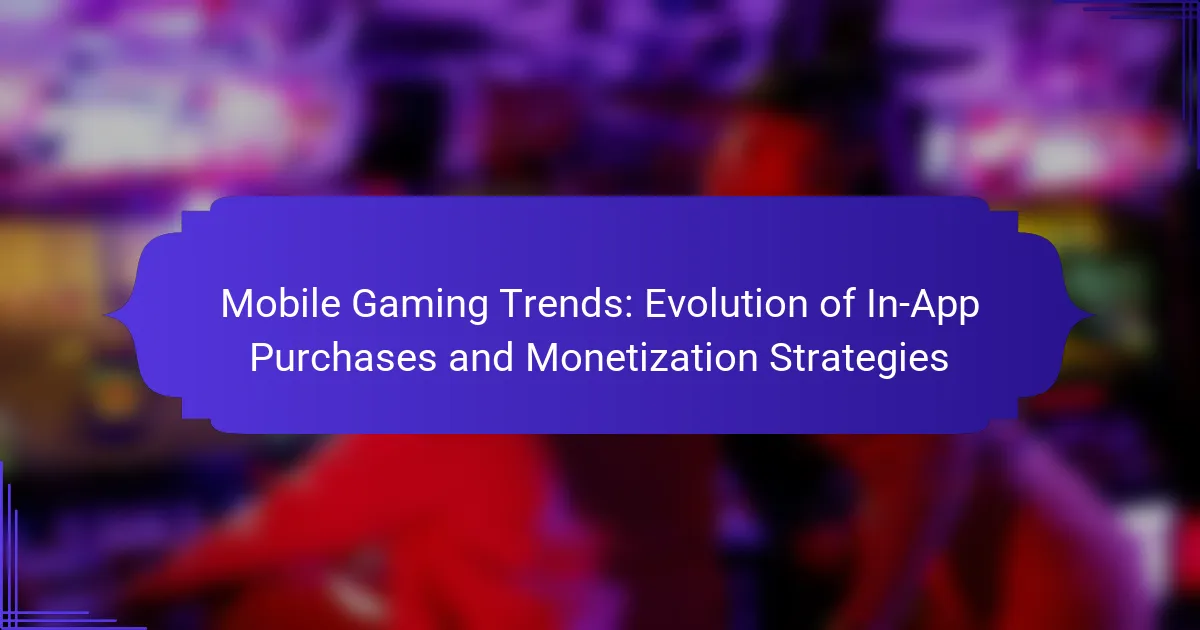Mobile gaming monetization is evolving rapidly, driven by player preferences and technological advancements. Subscription models and ad-based revenue are becoming mainstream. In-app purchases are tailored to enhance user experience and retention. Developers face challenges in maintaining user trust while optimizing revenue strategies.

What are the current trends in mobile gaming monetization strategies?
Mobile gaming monetization strategies are increasingly focused on subscription models and ad-based revenue. The rise of free-to-play games has shifted developers toward in-app purchases, offering players cosmetic items and gameplay enhancements. Subscription services are gaining traction, providing players with unlimited access to premium content for a monthly fee. Additionally, targeted advertising has evolved, utilizing player data to deliver personalized ad experiences. These trends reflect a dynamic landscape where monetization adapts to player preferences and market demands.
How do in-app purchases influence player engagement?
In-app purchases significantly enhance player engagement by providing immediate rewards and customization options. Players are more likely to invest time and money when they see tangible benefits. For example, exclusive items or faster progression can create a sense of achievement. This strategy not only boosts retention but also fosters a competitive environment among users. As a result, games with effective in-app purchase systems often report higher user satisfaction and increased lifetime value.
What role does advertising play in mobile game revenue?
Advertising significantly boosts mobile game revenue by providing a vital monetization channel. In-app advertisements create a steady income stream, enabling developers to offer free gameplay while generating profits. The effectiveness of targeted ads increases user engagement and retention, leading to higher revenue. Moreover, integrating ads with in-app purchases enhances overall monetization strategies, allowing players to enjoy content while supporting developers financially. As mobile gaming evolves, innovative ad formats like rewarded video ads are becoming essential for maximizing revenue potential.

Which factors drive the evolution of in-app purchase models?
The evolution of in-app purchase models is driven by user behavior, technological advancements, and market competition. User preferences for personalized experiences encourage developers to innovate monetization strategies. Emerging technologies, such as augmented reality, enhance engagement and create new revenue opportunities. Additionally, competition among mobile games pushes developers to adopt diverse pricing models to attract and retain players.
How do user demographics affect spending behavior?
User demographics significantly influence spending behavior in mobile gaming. Younger players tend to spend more on in-app purchases, while older demographics often prefer free-to-play models.
Gender also plays a role; studies show that female gamers are more likely to spend on cosmetic items, while male gamers often invest in gameplay advantages. Geographic location affects spending habits as well, with players in regions like North America and Europe generally spending more than those in Asia.
Additionally, income levels correlate with spending behavior; higher-income players are more inclined to make larger purchases. Understanding these demographic factors helps developers tailor monetization strategies effectively.
What impact do cultural differences have on monetization approaches?
Cultural differences significantly influence monetization approaches in mobile gaming. They affect user preferences for in-app purchases, pricing strategies, and promotional tactics. For instance, players in Asian markets often favor microtransactions, while Western audiences may prefer one-time purchases. Understanding these distinctions is crucial for developers to optimize revenue streams and enhance user engagement. Tailoring strategies to cultural nuances can lead to higher conversion rates and improved player retention.

How do developers optimize in-app purchases for user retention?
Developers optimize in-app purchases for user retention by enhancing user experience and offering personalized incentives. They analyze user behavior to tailor offerings, create engaging content, and implement strategic pricing.
Incorporating limited-time offers and exclusive items can drive urgency, while loyalty programs reward consistent spending. A/B testing different monetization strategies helps identify the most effective approaches.
User feedback is crucial; it informs developers about preferences, allowing for continuous improvement. Ultimately, these strategies foster a sense of community and keep players invested in the game.
What techniques enhance the perceived value of in-app purchases?
Techniques that enhance the perceived value of in-app purchases include offering exclusive content, creating limited-time offers, and implementing tiered pricing structures. Exclusive content, such as unique characters or levels, makes purchases feel special. Limited-time offers create urgency, encouraging players to buy before the opportunity ends. Tiered pricing structures allow users to choose from various options, catering to different spending capacities and increasing overall engagement.
Which psychological triggers are most effective in driving purchases?
Effective psychological triggers for driving purchases in mobile gaming include scarcity, social proof, and reward systems. Scarcity creates urgency, prompting players to act quickly. Social proof leverages user reviews and community engagement to build trust. Reward systems incentivize purchases by offering in-game benefits, enhancing player satisfaction and retention.

What unique monetization strategies are emerging in 2025?
Emerging monetization strategies in 2025 focus on player engagement and innovative revenue models. Subscription services for exclusive content and ad-free experiences are gaining traction. Additionally, blockchain integration allows for true ownership of in-game assets, enhancing player investment. Microtransactions are evolving, with personalized offers based on player behavior driving higher conversion rates.
How are subscription models reshaping the mobile gaming landscape?
Subscription models are significantly transforming the mobile gaming landscape by providing steady revenue streams for developers. These models encourage player retention through continuous content updates and exclusive benefits.
Players benefit from predictable costs, enhancing their gaming experience. For instance, popular games like Fortnite and Apple Arcade have successfully implemented subscription services, leading to increased player engagement.
The shift towards subscriptions also impacts monetization strategies, reducing reliance on in-app purchases. This approach fosters a more balanced ecosystem where players feel less pressured to spend.
As subscription models evolve, they may lead to innovative game design, focusing on long-term player satisfaction rather than short-term profits.
What innovative approaches are being taken to balance free-to-play and pay-to-win?
Innovative approaches to balance free-to-play and pay-to-win include implementing fair monetization strategies, enhancing player engagement, and offering meaningful rewards. Game developers are focusing on cosmetic items, which do not affect gameplay, to maintain competitive balance. Additionally, many games now feature battle passes that provide exclusive content without giving payers an unfair advantage. This ensures that all players can enjoy the game while still supporting developers financially.

What challenges do developers face with in-app purchases?
Developers face several challenges with in-app purchases, including user trust issues, compliance with app store regulations, and balancing monetization with user experience. Ensuring transparency in pricing and avoiding deceptive practices is crucial for maintaining user trust. Additionally, developers must navigate complex guidelines set by platforms like Apple and Google, which can vary significantly. Striking the right balance between generating revenue and providing a satisfying user experience remains a persistent challenge, as aggressive monetization strategies can lead to player dissatisfaction and increased churn rates.
How do regulatory changes impact monetization strategies?
Regulatory changes significantly influence monetization strategies in mobile gaming. New regulations can alter in-app purchase frameworks, affecting pricing models and user engagement. For instance, stricter data privacy laws may limit targeted advertising, reducing revenue from ad-based monetization. Additionally, compliance costs can impact profit margins, prompting developers to rethink pricing strategies. As regulations evolve, adapting monetization approaches becomes essential for sustained growth in the mobile gaming market.
What common pitfalls should developers avoid in pricing strategies?
Developers should avoid common pitfalls like underestimating player psychology, neglecting market research, and failing to adapt pricing models. Understanding user behavior and preferences is crucial for effective monetization.
1. Ignoring player feedback can lead to misaligned pricing strategies.
2. Overcomplicating in-app purchase options may confuse users and deter purchases.
3. Setting prices too high can alienate potential buyers.
4. Failing to offer value in free-to-play models can diminish user engagement.

What best practices can enhance in-app purchase effectiveness?
To enhance in-app purchase effectiveness, implement targeted strategies that focus on user engagement and personalization. Utilize data analytics to understand player behavior, and offer tailored promotions that align with their preferences. Incorporate limited-time offers to create urgency and encourage purchases. Optimize the user interface to simplify the purchasing process, reducing friction and enhancing the overall experience. Additionally, leverage social proof by showcasing popular items or user testimonials to build trust and drive sales.
How can data analytics improve monetization decisions?
Data analytics significantly enhances monetization decisions in mobile gaming by providing insights into player behavior and spending patterns. This data allows developers to tailor in-app purchase offerings and optimize pricing strategies. By analyzing user engagement metrics, developers can identify which features drive revenue and adjust their monetization strategies accordingly. For instance, targeted promotions based on player preferences can increase conversion rates and overall revenue. Additionally, predictive analytics can forecast future spending trends, enabling proactive adjustments to in-app offerings. Overall, leveraging data analytics leads to more informed and effective monetization strategies in mobile gaming.
What expert tips can help developers maximize revenue from in-app purchases?
To maximize revenue from in-app purchases, developers should implement targeted strategies. Focus on creating engaging content that encourages spending, such as limited-time offers or exclusive items. Utilize user data to personalize experiences and recommend purchases based on player behavior. Implement a tiered pricing model to cater to different spending capabilities, enhancing accessibility for all users. Lastly, regularly analyze performance metrics to refine monetization strategies and improve user retention.
